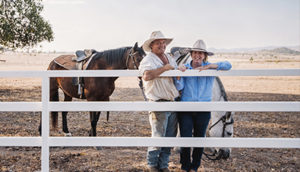Read the latest information on
Foot-and-mouth disease

Photo: Jessica Howard Photography
Central Queensland cattle producer Melinee Leather and her husband Rob are leaders in applying sound on-farm biosecurity and animal welfare practices on their properties and sharing their knowledge with others. Their work as advocates for the importance of biosecurity practices secured them an Australian Biosecurity Award in 2019, in the Farm Biosecurity Producer of the Year category.
“Managing biosecurity is one of the most important things we can do on our properties,” Melinee said.
“Good biosecurity underpins our markets and without it our whole industry is at risk.”
The Leathers have been practicing proactive and preventative biosecurity on-farm for around 20 years, a decision which has helped them maintain a range of accreditations, including being certified organic and European Union (EU) Cattle Accreditation Scheme accredited, securing them a number of lucrative markets.
“We are very aware of how important good biosecurity is to the markets we supply,” Melinee explained.
“To fit in with our EU accreditation all cattle on the property must also be EU eligible, have a National Livestock Identification System device and be lifetime traceable. When introducing cattle to our properties they are yarded for a minimum of seven days, placed in quarantine paddocks for a minimum of 21 days, and must be accompanied by a national vendor declaration and animal health declaration.”
Having multiple properties some distances apart also requires a robust system for transfers and introduction of new stock between them, to ensure any potential spread of diseases, parasites or weeds could be controlled. However, stock introductions are just a small element of the biosecurity management plans in place on each of the Leathers’ properties.
For people and vehicles coming on to the property, clear signage communicates biosecurity protocols, including the need to wash down the vehicle or remain in the designated areas. Visitors are asked to sign a visitor’s log, whilst feedstuff and other farm inputs must be accompanied by a commodity vendor declaration. Other activities, such as weed management and infrastructure maintenance, are built into the daily routine on the property.
“During a normal day, biosecurity is always occurring, whether you are mustering, fencing, doing general property work or water runs; everyone is looking at the cattle, the land and their surroundings for anything unusual,” Melinee said.
“Biosecurity requires some effort, time and money to ensure that you’re reducing risk, but when it’s embedded properly, best practice management occurs every day without consciously thinking about it.”
Both Melinee and Rob believe biosecurity simply makes sense for anyone farming livestock, and have worked extensively to convey the value of biosecurity to their industry peers.
“Good biosecurity practices will protect our people, environment and animals. A biosecurity outbreak will impact on profitability, productivity and property values,” they explained.
“Biosecurity is the responsibility of all of us and collectively we will increase the effectiveness of our surveillance and the speed at which we can return to trade should an incursion occur.”